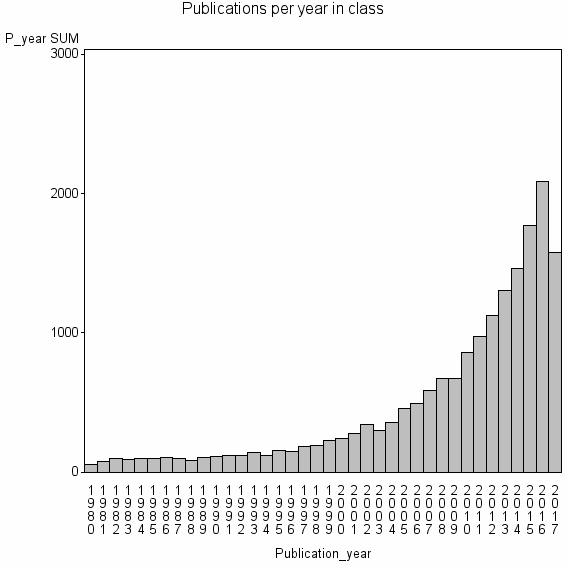
Class information for: |
Basic class information |

Hierarchy of classes |
The table includes all classes above and classes immediately below the current class. |
Terms with highest relevance score |
| rank | Category | termType | chi_square | shrOfCwithTerm | shrOfTermInClass | termInClass |
|---|---|---|---|---|---|---|
| 1 | PROBIOTICS | authKW | 2156987 | 18% | 38% | 3259 |
| 2 | GUT MICROBIOTA | authKW | 564063 | 4% | 44% | 735 |
| 3 | MICROBIOTA | authKW | 501654 | 5% | 32% | 912 |
| 4 | MICROBIOME | authKW | 351197 | 4% | 31% | 649 |
| 5 | BIFIDOBACTERIUM | authKW | 348852 | 2% | 48% | 420 |
| 6 | LACTOBACILLUS | authKW | 347863 | 4% | 29% | 682 |
| 7 | BENEFICIAL MICROBES | journal | 227135 | 1% | 56% | 233 |
| 8 | BIFIDOBACTERIA | authKW | 223901 | 2% | 37% | 343 |
| 9 | FECAL MICROBIOTA TRANSPLANTATION | authKW | 166363 | 1% | 79% | 121 |
| 10 | DYSBIOSIS | authKW | 164678 | 1% | 48% | 197 |
Web of Science journal categories |
| chi_square_rank | Category | chi_square | shrOfCwithTerm | shrOfTermInClass | termInClass |
|---|---|---|---|---|---|
| 1 | Microbiology | 111494 | 33% | 1% | 5979 |
| 2 | Gastroenterology & Hepatology | 24893 | 12% | 1% | 2091 |
| 3 | Nutrition & Dietetics | 20220 | 9% | 1% | 1690 |
| 4 | Biotechnology & Applied Microbiology | 16657 | 14% | 0% | 2528 |
| 5 | Food Science & Technology | 10799 | 10% | 0% | 1787 |
| 6 | Immunology | 6333 | 11% | 0% | 1907 |
| 7 | Infectious Diseases | 3369 | 5% | 0% | 869 |
| 8 | Allergy | 2757 | 2% | 1% | 364 |
| 9 | Pediatrics | 1004 | 4% | 0% | 650 |
| 10 | Multidisciplinary Sciences | 968 | 2% | 0% | 275 |
Address terms |
| chi_square_rank | term | chi_square | shrOfCwithTerm | shrOfTermInClass | termInClass |
|---|---|---|---|---|---|
| 1 | ALIMENTARY PHARMABIOT | 125223 | 1% | 27% | 266 |
| 2 | PROBIOGEN | 80639 | 0% | 79% | 58 |
| 3 | MICROBIOL BIOCHEM DAIRY PROD | 70945 | 0% | 60% | 68 |
| 4 | FUNCT FOODS FORUM | 60996 | 0% | 41% | 85 |
| 5 | C MICROBIOME | 55362 | 0% | 37% | 85 |
| 6 | METAB NUTR GRP | 45266 | 0% | 43% | 60 |
| 7 | ANIM PROD CHEM | 38136 | 0% | 47% | 46 |
| 8 | GENET BIOL MICROORGANISMS ANTHROPOL EVOLUT | 38102 | 0% | 66% | 33 |
| 9 | PROD LACTEOS ASTURIAS | 33946 | 0% | 29% | 66 |
| 10 | IMMUNOBIOTECHNOL | 33062 | 0% | 82% | 23 |
Journals |
| chi_square_rank | term | chi_square | shrOfCwithTerm | shrOfTermInClass | termInClass |
|---|---|---|---|---|---|
| 1 | BENEFICIAL MICROBES | 227135 | 1% | 56% | 233 |
| 2 | MICROBIOME | 103089 | 1% | 44% | 135 |
| 3 | ANAEROBE | 30504 | 1% | 10% | 170 |
| 4 | PROBIOTICS AND ANTIMICROBIAL PROTEINS | 22504 | 0% | 23% | 56 |
| 5 | GUT PATHOGENS | 15423 | 0% | 17% | 53 |
| 6 | ISME JOURNAL | 13407 | 1% | 6% | 123 |
| 7 | MICROBIAL ECOLOGY IN HEALTH AND DISEASE | 12339 | 0% | 20% | 35 |
| 8 | APPLIED AND ENVIRONMENTAL MICROBIOLOGY | 11249 | 3% | 2% | 454 |
| 9 | FRONTIERS IN MICROBIOLOGY | 10770 | 1% | 3% | 208 |
| 10 | INFLAMMATORY BOWEL DISEASES | 10266 | 1% | 5% | 131 |
Author Key Words |
| chi_square_rank | term | chi_square | shrOfCwithTerm | shrOfTermInClass | termInClass | LCSH search | Wikipedia search |
|---|---|---|---|---|---|---|---|
| 1 | PROBIOTICS | 2156987 | 18% | 38% | 3259 | Search PROBIOTICS | Search PROBIOTICS |
| 2 | GUT MICROBIOTA | 564063 | 4% | 44% | 735 | Search GUT+MICROBIOTA | Search GUT+MICROBIOTA |
| 3 | MICROBIOTA | 501654 | 5% | 32% | 912 | Search MICROBIOTA | Search MICROBIOTA |
| 4 | MICROBIOME | 351197 | 4% | 31% | 649 | Search MICROBIOME | Search MICROBIOME |
| 5 | BIFIDOBACTERIUM | 348852 | 2% | 48% | 420 | Search BIFIDOBACTERIUM | Search BIFIDOBACTERIUM |
| 6 | LACTOBACILLUS | 347863 | 4% | 29% | 682 | Search LACTOBACILLUS | Search LACTOBACILLUS |
| 7 | BIFIDOBACTERIA | 223901 | 2% | 37% | 343 | Search BIFIDOBACTERIA | Search BIFIDOBACTERIA |
| 8 | FECAL MICROBIOTA TRANSPLANTATION | 166363 | 1% | 79% | 121 | Search FECAL+MICROBIOTA+TRANSPLANTATION | Search FECAL+MICROBIOTA+TRANSPLANTATION |
| 9 | DYSBIOSIS | 164678 | 1% | 48% | 197 | Search DYSBIOSIS | Search DYSBIOSIS |
| 10 | INTESTINAL MICROBIOTA | 161537 | 1% | 36% | 260 | Search INTESTINAL+MICROBIOTA | Search INTESTINAL+MICROBIOTA |
Core articles |
The table includes core articles in the class. The following variables is taken into account for the relevance score of an article in a cluster c: (1) Number of references referring to publications in the class. (2) Share of total number of active references referring to publications in the class. (3) Age of the article. New articles get higher score than old articles. (4) Citation rate, normalized to year. |
Classes with closest relation at Level 2 |